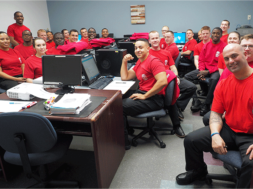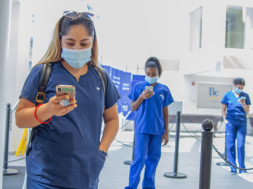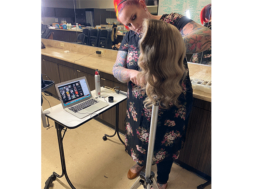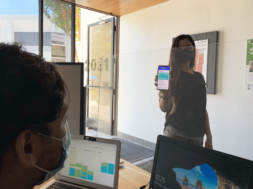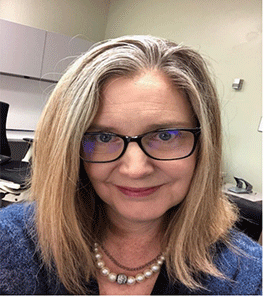
Humanity in Our Hands: Educators Embrace Diversity, Equity, and Inclusion
By Dana M. Grant, DNP, RN, CNE, NEA-BC, Associate Professor, Radford University
Introduction
Diversity has become an important concept with an increased United States population, explosion of technology allowing communication to occur in seconds between individuals across the globe and ease of international travel. Globalization enables students to participate in new and unique, nontraditional education methods. While new opportunities are available to students, educators are expected to embrace differences among students while providing a meaningful learning experience.
To understand differences, educators must have a solid foundation of knowledge with diversity, equity, and inclusion (DEI) terminology.
The knowledge leads to transformation change through intrinsic motivation of students to improve success within the educational setting (Armstrong, 2019). All people deserve to benefit from the ability to learn from each other and to grow into their own unique person.
Background
From 1997 to 2017, the United States experienced extreme racial and ethnic makeup and education attainment changes within the population. During this time, the population increased more than 50 million people, with most of the population increase being people of color. Hispanics or Latinos accounted for the largest group of racial and ethnic growth with the total increase of population, from 11.1% in 1997 to 18% in 2017. Asians followed with an increase in population from 3.7% to 5.7%. Interestingly, Caucasians remain the largest racial and ethnic group although the overall population declined from 71.9% in 1997 to 61% in 2017 (American Council on Education [ACE], 2021).
More of the population of adults ages 25 and older increased enrollment and completion of some type of postsecondary education. In 2017, Asians had the highest levels of postsecondary education attainment. Hispanic men and women along with Alaska Native men and American Indian had the lowest levels of educational attainment at any level, with high school credential or less accounting for half of the population. Adults from ages 35 to 44 had the highest level of education attainment when taking into consideration all racial and ethnic groups. Hispanics followed a different path and with every 10-year age increase having higher rates of post-secondary education attainment than the previous younger group. The first minority-White generation at 49.6% pointed to the current shift in demographics to an increase of non-White children at every age from infant to nine years. The United States population became more educated with an estimated 44% of the population ages 25 and older achieving a postsecondary degree, a significant increase from an estimated 31% in 1997. Unfortunately, although educational attainment has increased for racial and ethnic minorities, disparities remain high. This trend is worrisome, because those who obtain a postsecondary education have a better opportunity to earn higher wages, purchase homes, vote, volunteer and have less health issues due to healthier lifestyles.
The demographic information acknowledges that a large percentage of Americans are left without opportunities to improve their lives and become productive contributors to society (ACE, 2021).
Diversity when achieved with equity and inclusion, supports racial and cultural awareness, promotes critical thinking and active involvement in service to community and overall, a more educated society, to name a few (Clayton, 2021). However, with the changing demographics supporting more cultural awareness for diversity, equity and inclusion, the terms must be approached by higher education with a broadened view to meet the expectation to embrace the uniqueness of the individual. Diversity, equity, and inclusion terminology has been utilized differently depending on the time. Inclusion was not thought about 20 years ago when discussing diversity. Diversity was primarily focused on ethnic and racial connotations. Factors such as sexual orientation and socioeconomic were not conceptualized (Armstrong, 2019). Equity and inclusion are important at the present time because when there is more diversity in the student population, educators must have awareness and innovative approaches to ensure students are treated fairly which facilitates a sense of belonging.
Solution
The definition of diversity, equity, and inclusion must be provided to educators. Diversity represents a unique combination of race, ethnicity, sexual orientation, age, religion language, socioeconomic and experiences of an individual or group. Equity involves treating individuals fairly by avoiding barriers that prevent separation of individuals into marginal groups. Inclusion allows EVERYONE to fully participate regardless of differences and EVERYONE is welcomed and respected (Effland et al., 2020). Respecting cultural integrity of every learner becomes a motivational action for educators that understand the differences and connectedness between diversity, equity, and inclusion. The Motivation Framework for Culturally Responsive Teaching elicits intrinsic motivation from all students. Four strategies must be present for educators to sustain a learning plan that will support diversity, equity, and inclusiveness. The strategies are establishing respect and connectedness, developing a positive attitude, establishing meaning by engagement to overcome challenges, and effectiveness of student learning (Ginsberg, 2018).
Connectedness can be best exemplified in many ways. For example, when educators participate on educator interview panels, educators must seek employees with diverse characteristics. Students learn from role models with diverse backgrounds because they grasp the contextual nature of the community and then can identify health needs, etc., to prepare them to be competent health-care professionals. Students can learn about teamwork and collaboration while using experiential learning activities such as flipped classrooms, group case study assignments and volunteer opportunities within the community. Flipped classroom allows educators to strategically plan diverse work groups by assigning students to work together in small breakout groups in class to review a case study, answer questions or pose a solution to a complex issue that uses critical thinking skills within the group. Volunteer work can be easily found for students and can be simple services such as car washing or working a car show to encourage interaction with a variety of community members with diverse backgrounds. The activities help to build understanding and an appreciation for the gifts everyone contributes to society. The diversity of the student and employee population in academic population reduces inclusion and promotes equity.
The educator with expertise collaborating among students of various backgrounds will focus on encouraging college administrators to form a partnership with workforce initiatives that will come to the college to develop a rapport and assist students with a wide variety of needs to develop a positive attitude and eliminate obstacles to admission, progression, and retention in programs. The mentorship facilitates a student-centered approach to academia and the basic skill set of demonstrating humanity to others with the goal of successful job placement at the end of the academic experience.
A positive mindset can be transformed by becoming aware of unconscious bias. Bias are attitudes and assumptions that one person holds toward another person or group.
The beliefs play a role in educators’ perceptions and interactions with students. Research reports that professors have a tendency at all levels to call on white, male students most frequently. In addition, there is a tendency for educators to equate lower proficiency in spoken English with suboptimal writing skills. These examples are only a few of the many situations of unconscious bias in education but unfortunately, the bias can hinder student recruitment, engagement, retention and completion of educational goals and stifle career opportunities. To address bias, educators must commit themselves and students to embrace discomfort and start with awareness and acknowledgement of bias. One approach involves spending time with other educators and students who are not like yourself to foster deeper understanding of the broad range of human experiences. Critical thinking and self-reflection can promote a better understanding and the willingness as educators to change perspectives and actions to embrace the uniqueness of the individual (Bowman, 2020).
Educators must strongly consider expanding their borders and applying for and successfully obtaining grant funds to help students through stipends and purchasing books, and tuition assistance to improve inclusion (the philosophy-every student can do this with support, and resources-it makes all the difference!) Students need encouragement to speak up and utilize the formal grievance process for concerns related to equity and inclusion to promote process improvements in the college to ensure diversity, inclusion, and equity. Students that experience culturally responsive teaching demonstrate open, transparent communication, reduction in stress with enhanced creativity and will likely become lifelong learners (Ginsberg, 2018).
Conclusion
An understanding of diversity, equity, and inclusion terminology is the beginning of the ongoing process to gain self-awareness as an educator to reduce student learning barriers. Diversity has broadened to incorporate many perspectives and worldviews and as a result, equity and inclusion can be harder to achieve than in simpler times before the population boom, real-time communication and ease of travel was available (Armstrong, 2019). As educators work to transform institutional climates to provide equity-focused learning cultures, educators and students from underrepresented groups will sense belonging and choose to come, remain and be successful contributors within their educational realm (Effland et al., 2020). The forever changing culture of today must prepare students with culturally responsive teaching methodology that will establish the relationship between intrinsic motivation and learning into a deliberate and positive student learning outcome (Ginsberg, 2018).
References
American Council on Education. (2021). United States: population trends and educational attainment. https://www.equityinhighered.org/indicators/u-s-population-trends-and-educational-attainment/race-and-ethnicity-of-the-u-s-population/
Armstrong, K. (2019, June 25). What exactly is diversity, equity, and inclusion? National Association of Colleges and Employers. https://community.naceweb.org/blogs/karen-armstrong1/2019/06/25/what-exactly-is-diversity-equity-and-inclusion
Bowman, K.D. (2020, August 4). Strategies for countering unconscious bias in the classroom. National Association of International Educators. https://www.nafsa.org/ie-magazine/2020/8/4/strategies-countering-unconscious-bias-classroom
Clayton, T. B. (2021, January 13). Refocusing on diversity, equity, and inclusion during the pandemic and beyond: Lessons from a community of practice. HigherEducationToday. https://www.higheredtoday.org/2021/01/13/refocusing-diversity-equity-inclusion-pandemic-beyond-lessons-community-practice/
Effland, K.J., Hays, K., Ortiz, F.M., & Blanco, B.A. (2020). Incorporating an equity agenda into health professions education and training to build a more representative workforce. Journal of Midwifery & Women’s Health, 65, 149-159. https://doi.org/10.1111/jmwh.13070
Ginsberg, M. (2018, May 16). A motivational framework for instructional equity in higher education. HigherEducationToday. https://www.higheredtoday.org/2018/05/16/motivational-framework-instructional-equity-higher-education/
DR. DANA M. GRANT is an experienced nurse with over 30 years of healthcare experience. She has a diverse background including quality management, patient safety, risk management, teaching, mentoring and precepting at the undergraduate, graduate, and doctoral level. Dr. Grant has been a leader in the academic setting as an Interim Dean and Academic Director for a nursing college. Some of her skills include, but are not limited to administrative, faculty and staff workload, clinical scheduling and onboarding of students, community enrichment through funds obtained with grant writing, recruiting and fundraising planning and participation, contractual partnership with workforce development organizations, attending and presenting at nursing conferences and research projects. Dr. Grant has obtained the National League of Nursing (NLN) Certified Nurse Educator (CNE), which is considered a gold standard for nursing education. In addition, achieving Nurse Executive Advanced-Board Certified by the American Nurse Credentialing Center (ANCC) demonstrates the ability to provide leadership and administration capabilities within an academic environment. Dr. Grant is enthusiastic and confident in her ability to synthesize research and expert experience into a white paper that will facilitate diversity, equity, and inclusion concepts to become more meaningful and applicable to educators’ everyday practice. Indeed, learning must prevail in a forever changing world that needs to be embraced.
Contact Information: Dr. Dana M. Grant, DNP, RN, CNE, NEA-BC // Radford University Associate Professor // 434-610-6728 // dmgrant@radford.edu or grant.dana68@gmail.com // http://www.radford.edu // https://www.facebook.com/RadfordUniversity/



